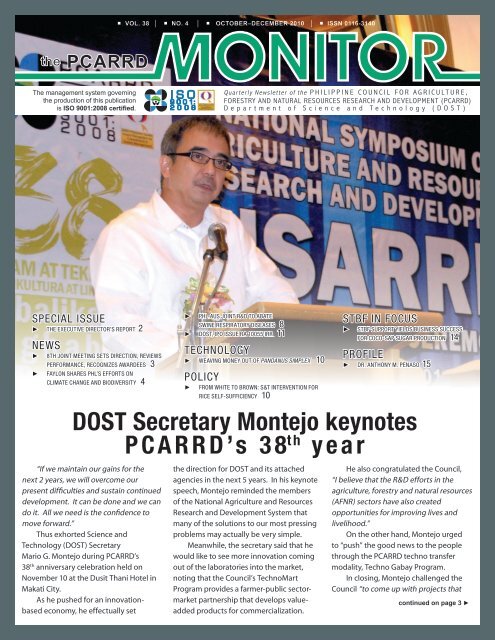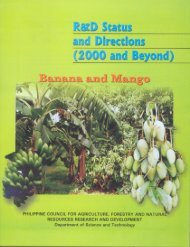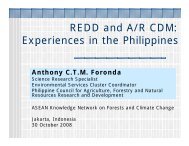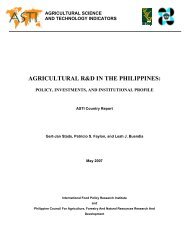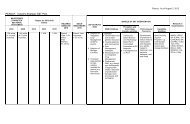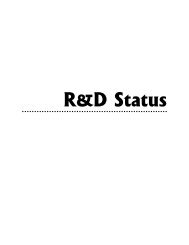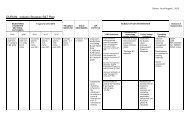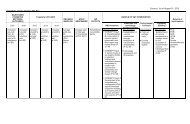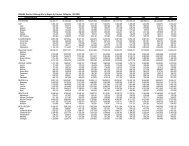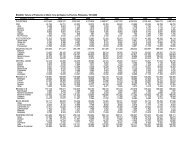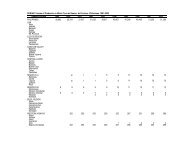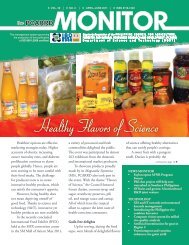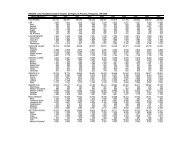DOST Secretary Montejo keynotes PCARRD's 38th year - pcaarrd ...
DOST Secretary Montejo keynotes PCARRD's 38th year - pcaarrd ...
DOST Secretary Montejo keynotes PCARRD's 38th year - pcaarrd ...
Create successful ePaper yourself
Turn your PDF publications into a flip-book with our unique Google optimized e-Paper software.
■ Vol. 38 │ ■ No. 4 │ ■ OCTOBER–DECEMBER 2010 │ ■ ISSN 0116-3140<br />
the PCARRD<br />
The management system governing<br />
the production of this publication<br />
is ISO 9001:2008 certified.<br />
ISO<br />
9001:<br />
2008<br />
Quarterly Newsletter of the PHILIPPINE COUNCIL FOR AGRICULTURE,<br />
FORESTRY AND NATURAL RESOURCES RESEARCH AND DEVELOPMENT (PCARRD)<br />
Department of Science and Technology (<strong>DOST</strong>)<br />
SPECIAL ISSUE<br />
► THE EXECUTIVE DIRECTOR’S REPORT 2<br />
NEWS<br />
► 8TH JOINT MEETING SETS DIRECTION, REVIEWS<br />
PERFORMANCE, RECOGNIZES AWARDEES 3<br />
► FAYLON SHARES PHL’S EFFORTS ON<br />
CLIMATE CHANGE AND BIODIVERSITY 4<br />
<strong>DOST</strong> <strong>Secretary</strong> <strong>Montejo</strong> <strong>keynotes</strong><br />
PCARRD’s 38 th <strong>year</strong><br />
“If we maintain our gains for the<br />
next 2 <strong>year</strong>s, we will overcome our<br />
present difficulties and sustain continued<br />
development. It can be done and we can<br />
do it. All we need is the confidence to<br />
move forward.”<br />
Thus exhorted Science and<br />
Technology (<strong>DOST</strong>) <strong>Secretary</strong><br />
Mario G. <strong>Montejo</strong> during PCARRD’s<br />
38 th anniversary celebration held on<br />
November 10 at the Dusit Thani Hotel in<br />
Makati City.<br />
As he pushed for an innovationbased<br />
economy, he effectually set<br />
► PHL-AUS JOINT R&D TO ABATE<br />
SWINE RESPIRATORY DISEASES 8<br />
► <strong>DOST</strong>, IPO ISSUE RA 10055 IRR 11<br />
TECHNOLOGY<br />
► WEAVING MONEY OUT OF PANDANUS SIMPLEX 10<br />
POLICY<br />
► FROM WHITE TO BROWN: S&T INTERVENTION FOR<br />
RICE SELF-SUFFICIENCY 10<br />
the direction for <strong>DOST</strong> and its attached<br />
agencies in the next 5 <strong>year</strong>s. In his keynote<br />
speech, <strong>Montejo</strong> reminded the members<br />
of the National Agriculture and Resources<br />
Research and Development System that<br />
many of the solutions to our most pressing<br />
problems may actually be very simple.<br />
Meanwhile, the secretary said that he<br />
would like to see more innovation coming<br />
out of the laboratories into the market,<br />
noting that the Council’s TechnoMart<br />
Program provides a farmer-public sectormarket<br />
partnership that develops valueadded<br />
products for commercialization.<br />
STBF IN FOCUS<br />
► STBF SUPPORT YIELDS BUSINESS SUCCESS<br />
FOR COCO-SAP SUGAR PRODUCTION 14<br />
PROFILE<br />
► DR. ANTHONY M. PENASO 15<br />
He also congratulated the Council,<br />
“I believe that the R&D efforts in the<br />
agriculture, forestry and natural resources<br />
(AFNR) sectors have also created<br />
opportunities for improving lives and<br />
livelihood.”<br />
On the other hand, <strong>Montejo</strong> urged<br />
to “push” the good news to the people<br />
through the PCARRD techno transfer<br />
modality, Techno Gabay Program.<br />
In closing, <strong>Montejo</strong> challenged the<br />
Council “to come up with projects that<br />
continued on page 3 ►
SPECIAL ISSUE: The Executive Director’s Report<br />
Agham at Teknolohiya sa Agrikultura at Likas na Yaman:<br />
Kabalikat sa Pagbabago at Pag-unlad<br />
One of the greatest challenges<br />
confronting humanity today is the<br />
sustainability of resources amid a growing<br />
human population, rapidly increasing use<br />
of natural resources and the environmental<br />
stresses. The role of innovators and the<br />
scientific community of the country is<br />
essential, though currently insufficient.<br />
To address this, the Science and<br />
Technology Agenda (STA) guided collective<br />
investments on major S&T activities in the<br />
medium term. It harmonized the agenda of the<br />
National Agriculture and Resources Research<br />
and Development System (NARRDS) based on<br />
commonalities and complementation.<br />
The regimes of innovation have<br />
incorporated new structures and practices<br />
for commercial use, thus indicating a new<br />
kind of relationship between public and<br />
private sector, between local and international<br />
organizations. Thus, as PCARRD celebrates<br />
its <strong>38th</strong> <strong>year</strong> of delivering a dynamic<br />
leadership in S&T innovation in the AFNR<br />
sectors, it envisions strengthened strategies<br />
to contribute to S&T trends and address<br />
needs in the sectors.<br />
Here then are PCARRD’s efforts in<br />
delivering the quality of service that the<br />
people deserve.<br />
Focused S&T-based Innovation<br />
Contribution to existing knowledge<br />
and skills is one of the tenets of PCARRD.<br />
However, our approach is not just to produce<br />
quality results, but also to provide institutional<br />
support and contributions to the whole policy<br />
environment in S&T.<br />
Policy<br />
a. Enhancing the Country’s Innovation<br />
System through the Philippine<br />
Technology Transfer Act of 2009.<br />
PCARRD helped propelled the enactment<br />
of R.A 10055 or the Philippine Technology<br />
Transfer Act of 2009 on March 23, 2010.<br />
The law officially took<br />
effect on May 8. We<br />
played a significant role<br />
in the bill’s legislative<br />
advocacy and public<br />
awareness activities,<br />
including the crafting of<br />
its Implementing Rules<br />
and Regulations (IRR).<br />
At present, the Council<br />
is at the forefront of<br />
crafting the guidelines<br />
on intellectual<br />
property valuation,<br />
commercialization, and<br />
information sharing.<br />
b. Organic Agriculture<br />
Act of 2010. PCARRD<br />
also contributed<br />
significantly in the<br />
signing of RA 10068 or<br />
the Organic Agriculture<br />
Act of 2010 on April<br />
6, 2010. We provided<br />
inputs during the<br />
drafting of the House Bill and participated<br />
in its IRR formulation.<br />
c. E.O. 801. We also pushed for signing of<br />
Executive Order No. 801 on Techno Gabay<br />
Program (TGP). A Steering Committee<br />
and a Technical Working Committee are<br />
now finalizing IRR. The draft IRR was<br />
reviewed and presented during the 3 rd<br />
National Symposium of the Philippine<br />
Extension Network (PEN). In June 2010,<br />
PCARRD decided to transfer the TGP to<br />
the Department of Agriculture-Agricultural<br />
Training Institute after a 2-<strong>year</strong> transition<br />
period.<br />
d. 2011–2016 PCARRD Corporate Plan<br />
(CorPlan). In 2009, the Madecor Group,<br />
Inc., reviewed the mid-term performance<br />
of the CorPlan for 2005–2008. The<br />
review showed that the CorPlan has been<br />
successfully implemented for the period in<br />
review. The reviewer also recommended<br />
the continuance of programs to enhance<br />
the CorPlan’s implementation. The review<br />
also recommended measures for the<br />
preparation of the next CorPlan.<br />
Crafting of the 2011–2016 CorPlan<br />
and the STA for the same period started<br />
this <strong>year</strong> with a stakeholders’ consultation<br />
held on June 29.<br />
e. STA on Climate Change Initiatives. A<br />
PCARRD TWG on Climate Change was<br />
formed on February 9, 2010 to disseminate<br />
information, establish links to different<br />
organizations, craft reports for the<br />
Council’s executive director, inventory R&D<br />
projects, and plan, package, evaluate,<br />
monitor, and coordinate all climate changerelated<br />
national S&T projects/programs.<br />
Resiliency of food production areas<br />
(Strategic Agriculture and Fisheries<br />
Development Zones [SAFDZ]) was the<br />
focus of a workshop and a summit<br />
continued on page 5 ►<br />
2 October–December 2010
NEWS<br />
▼ Sec. <strong>Montejo</strong> ... (from page 1)<br />
would give more than hope especially<br />
for the poor.”<br />
“We must take that one more<br />
step beyond mere generation of S&T<br />
information and technologies, and<br />
provide opportunities for livelihoods<br />
that would put food on the table,<br />
improve access to basic health services,<br />
and education for all.”<br />
Launchings<br />
Also highlighting the celebration,<br />
themed as “Agham at teknolohiya sa<br />
agrikultura at likas na yaman: Kabalikat<br />
sa pagbabago at pag-unlad”, was<br />
the Executive Director’s Report of Dr.<br />
Patricio S. Faylon of the <strong>year</strong> that was.<br />
The occasion also served as<br />
the venue for the soft launch of the<br />
Council’s Corporate Plan (CorPlan)<br />
2011–2016 and the presentation of the<br />
2006–2010 accomplishments of the<br />
Science and Technology Agenda (STA).<br />
According to Faylon, the CorPlan<br />
is “grounded on the <strong>DOST</strong> economybased<br />
framework where innovation<br />
success will be a product of many<br />
stakeholders collaborating and sharing<br />
the risk of change.”<br />
Faylon explains that the CorPlan<br />
is a blueprint for the implementation<br />
of the Council’s plans and programs.<br />
“It was designed to make science and<br />
technology the driving force for AFNR,”<br />
he said.<br />
“It presents how the Council will<br />
position itself toward producing food,<br />
generating jobs, creating livelihood<br />
opportunities, and rehabilitating natural<br />
resources.”<br />
The STA, on the other hand, sets<br />
the direction of the AFNR sectors based<br />
on the Council’s banner programs on<br />
knowledge and technology generation,<br />
R&D results utilization, policy research,<br />
and R&D governance within the context<br />
of the Philippine Agriculture (PA) 2020.<br />
PA 2020 is a long-term plan that<br />
integrates agriculture (crop, livestock,<br />
fisheries), environment and natural<br />
resources (forestry products), and social<br />
systems.<br />
Awards<br />
On its 38 th <strong>year</strong>, PCARRD conferred<br />
its biennial awards to its regional<br />
partners.<br />
First in the roster was the PCARRD<br />
Professional Media Awards with<br />
Noel T. Provido of the Department of<br />
Agriculture-Regional Field Unit (DA-RFU)<br />
11 winning in the print category.<br />
For the broadcast category, the<br />
University of the Philippines Los Baños’<br />
(UPLB) DZLB Tinig ng Agrikultura sa<br />
Barangay Program Team won.<br />
Winning the Tanglaw Award for Most<br />
Outstanding Research Institution was<br />
the Philippine Rootcrops Research and<br />
Training Center in Region 8.<br />
The Pantas Award for Most<br />
Outstanding Research Administrator<br />
went to Dr. Jose L. Bacusmo, president<br />
of the Visayas State University (VSU). For<br />
the researcher category, Dr. Roberto C.<br />
Guarte, also of VSU, won.<br />
For the most outstanding regional<br />
consortium or the Ugnay Awards,<br />
the Southern Mindanao Agriculture<br />
Resources Research and Development<br />
Consortium (SMARRDEC) ended<br />
up as second runner up. The Ilocos<br />
Agriculture and Resources Research and<br />
Development Consortium (ILARRDEC)<br />
won first runner up. Bagging the<br />
grand prize was the Cagayan Valley<br />
Agriculture and Resources Research and<br />
Development Consortium (CVARRD).<br />
NSARRD<br />
In the National Symposium on<br />
Agriculture and Resources Research<br />
and Development (NSARRD), an annual<br />
competition which precedes the<br />
Council’s anniversary celebration, UPLB<br />
won in two categories.<br />
The university won first place in<br />
the research category for the paper on<br />
“Coconut biotechnology: Gene discovery<br />
of fatty acid/triglyceride biosynthesis,<br />
cocosin promoter and tissue culturetransformation<br />
in corn as model<br />
system. It also won second place in the<br />
development category for their entry<br />
“Improving production of Saba, Lakatan,<br />
and Latundan cultivars in different<br />
cropping systems.”<br />
Other winners in the research<br />
category include the Philippine Coconut<br />
Authority-Zamboanga Research<br />
Center’s “Accelerated development of<br />
coconut synthetic variety using classical<br />
breeding methods and microsatellite<br />
marker technology,” second place;<br />
and “Ultrastructural biology and<br />
pathogenesis of lignicolous fungi<br />
causing rotting of citrus branch” of the<br />
Nueva Vizcaya State University and<br />
Maejo University of Thailand, third place.<br />
In the development category, the<br />
top prize went to “Rural Enterprise<br />
Development through innovative goat<br />
production systems” of DA-RFU 8, Central<br />
Luzon State University, and Isabela State<br />
University. In third place was “Production<br />
and dispersal of improved week-old and<br />
40–45 day-old Philippine native (‘darag’)<br />
chicks of the Western Visayas State<br />
University. (Butch S. Pagcaliwagan)<br />
8 th joint meeting sets<br />
direction, reviews<br />
performance,<br />
recognizes awardees<br />
PCARRD held the 8th National Joint<br />
Regional Research and Development<br />
Coordinating Committee (RRDCC)<br />
Chairpersons and Consortium Directors’<br />
(CD) Meeting last October 20–22, 2010 at<br />
One Tagaytay Place, Tagaytay City where<br />
the Council assessed and set national<br />
directions for 2011–2016.<br />
PCARRD Deputy Executive Director<br />
for R&D Danilo C. Cardenas updated<br />
the participants on the crafting of the<br />
S&T Agenda for 2011–2016. The Agenda<br />
continued on page 4 ►<br />
The PCARRD Monitor 3
NEWS<br />
▼ 8 th joint meeting ... (from page 3)<br />
provides a clear vision and approach to<br />
ensure sustainable food security amidst<br />
climate change, meet food demands,<br />
and promote resiliency of natural<br />
resources against depletion/degradation.<br />
It translates PCARRD’s vision and mission<br />
into concrete plan of actions or focused<br />
activities through specific, measurable,<br />
feasible, and time-bound targets.<br />
Cardenas informed the consortium<br />
directors and chairpersons on the results<br />
of the STA consultations done across<br />
the country. He stressed the need for<br />
the regional consortia to align their<br />
proposed activities on their assigned<br />
commodities to support the approved<br />
Regional Development Plan.<br />
While Cardenas focused on future<br />
directions of the regional consortia,<br />
PCARRD Deputy Executive Director for<br />
Institution Development and Resource<br />
Management Richard M. Juanillo<br />
helped the consortia evaluate their<br />
performances in 2009. Their performance<br />
were also the basis for the new<br />
assignments of PCARRD management<br />
staff as RRDCC representatives to help<br />
improve or maintain the consortia’s<br />
implementation of regional programs.<br />
On a lighter note, PCARRD Executive<br />
Director Patricio S. Faylon and the<br />
rest of the PCARRD delegates to the<br />
meeting congratulated the winners<br />
of the PCARRD R&D Awards, namely,<br />
Ugnay (Outstanding Consortium), Pantas<br />
(Outstanding Researcher/Scientist<br />
and Research Administrator), Tanglaw<br />
(Outstanding Research Institution),<br />
Professional Media (Broadcast and Print),<br />
and Best R&D Papers. The awards will<br />
be conferred during PCARRD’s <strong>38th</strong><br />
Anniversary in Dusit Thani Hotel, Makati<br />
City. (Pia Paula P. Mateo)<br />
PCARRD ED Patricio Faylon (1st row, center), is joined by the RRDCC Chairpersons,<br />
consortium directors, STARRDEC staff, and selected PCARRD staff during the 8 th Joint<br />
RRDCC and Consortium Directors’ Meeting.<br />
Faylon shares PHL’s<br />
efforts on climate<br />
change and biodiversity<br />
PCARRD Executive Director<br />
Patricio Faylon went on a mission to<br />
Korea to share the national program<br />
and strategies to mitigate and adapt<br />
to climate change in the Philippines,<br />
and to show the present and future<br />
activities/initiatives on agrobiodiversity<br />
conservation and use in the country.<br />
Together with country<br />
representatives from Malaysia, Vietnam,<br />
Sri Lanka, China, India, Australia, and<br />
Korea, Faylon started on his mission<br />
through the 14th Annual Meeting of the<br />
Council for Partnership on Rice Research<br />
in Asia (CORRA) last October 11–12, 2010<br />
at the Rural Development Administration<br />
(RDA), Korea. During the meeting, Faylon<br />
presented the Philippine S&T Agenda<br />
on Climate Change for the agriculture,<br />
forestry and natural resources (AFNR)<br />
sectors for 2010–2016.<br />
The S&T Agenda aims to sustain<br />
productivity and competitiveness of<br />
the AFNR sectors in the midst of climate<br />
change. It focuses on themes such as<br />
vulnerability and impact assessment,<br />
response mechanism, policies and<br />
institutions, and crosscutting concerns.<br />
At present, the Agenda has come<br />
up with the State of the Art on the<br />
Socioeconomics of Climate Change in<br />
the Philippines: Experts’ Synthesis and<br />
Benchmarking which is being prepared<br />
for publication.<br />
Faylon also had the opportunity<br />
to impart the efforts of the Philippines<br />
on agro-biodiversity conservation and<br />
utilization through the International<br />
Symposium on Sustainable<br />
Agricultural Development and Use<br />
of Agrobiodiversity in the Asia Pacific<br />
Region last October 13–14, 2010<br />
organized by RDA, the Asia-Pacific<br />
Association of Agricultural Research<br />
Institutes (APAARI) and the Bioversity<br />
International.<br />
The Philippines recognizes the<br />
importance of agricultural biodiversity<br />
since many plant species are used<br />
for food, medicine, fiber, essential oil,<br />
commercial timber, and ornamental.<br />
With various advantages and uses<br />
of these plants, threats to Philippine<br />
biodiversity exist such as habitat loss and<br />
destruction, biological, chemical, and<br />
environmental pollution, displacement<br />
of indigenous crop species and varieties,<br />
and natural disasters.<br />
Different national institutions<br />
and networks work together to help<br />
conserve and regulate the proper use of<br />
the plant genetic resources (PGR) such<br />
as the Philippine Rice Research Institute<br />
continued on page 8 ►<br />
4 October–December 2010
▼ Special Issue ... (from page 2)<br />
held for the Luzon and Mindanao S&T<br />
Programs, respectively. The PCARRD-<br />
SEARCA project “State of the Art (SOA)<br />
on the Socioeconomics of climate change:<br />
Experts’ synthesis and benchmarking” final<br />
publication is being technically reviewed<br />
and edited.<br />
Focused S&T<br />
a. Banana. This <strong>year</strong> [2010], 14 institutions<br />
implemented a new banana program – the<br />
National Integrated Banana R&D Program<br />
(NIBRDP) funded by <strong>DOST</strong> and PCARRD.<br />
The program focused on the adoption of a<br />
package of technology (POT) for Lakatan,<br />
Latundan, and Saba in 73-hectare<br />
cooperators’ farms in major growing<br />
municipalities in Regions 2, 11, and Caraga<br />
and the establishment of 15-hectare demo<br />
sites in Region 9.<br />
A Geographic Information System<br />
(GIS) database for existing banana<br />
plantations in Region 2 was established<br />
and maps were generated/validated.<br />
Collection, selection, and mass<br />
propagation of potentially dwarf Saba<br />
and Cardaba for irradiation and possible<br />
development of Saba/Cardaba strain are<br />
currently in full swing. As well, resistance<br />
of existing Musa germplasm against major<br />
viruses is being evaluated. Moreover, the<br />
facilities for virus indexing had already<br />
been completed.<br />
b. Biofuel. PCARRD continues to provide<br />
S&T-based information and technologies<br />
supportive of the Biofuels Act of 2006. The<br />
National Biofuels R&D Program (NBRDP)<br />
has two subprograms on (1) nonfood<br />
feedstock sources for biodiesel and<br />
(2) bioethanol production in degraded,<br />
marginal, and idle areas not fitted for food<br />
production.<br />
Jatropha. R&D on Jatropha focused on the<br />
characterization and performance selection<br />
of germplasm suited for plantation<br />
development (3–6 <strong>year</strong>s). PCARRD also<br />
initiated the consolidation and packaging<br />
of the Jatropha Production and Processing<br />
Manual, which contained information from<br />
R&D endeavors in the Philippines.<br />
Sweet Sorghum. The subprogram on sweet<br />
sorghum under the <strong>DOST</strong>-PCARRD Biofuels<br />
R&D Program is now on its second phase.<br />
The performance evaluation of sweet<br />
sorghum lines showed that SPV 422, an<br />
International Crops Research Institute for<br />
the Semi-Arid Tropics (ICRISAT) variety,<br />
gave good results on all parameters tested<br />
across seven locations. Environmental<br />
factors such as light intensity and rainfall<br />
affected maturity and sugar content.<br />
These will be used in the formulation of<br />
the package of technology (POT) for sweet<br />
sorghum.<br />
c. Bamboo. PCARRD has an on-going<br />
program promoting the use of engineered<br />
bamboo or e-bamboo for construction and<br />
furniture. In its second <strong>year</strong>, 3 hectares<br />
of Kawayan tinik and 2 hectares of giant<br />
bamboo have been planted in Laguna.<br />
d. Yellow Corn (Quality Protein Maize).<br />
The Development of High Quality Protein<br />
Maize (QPM) project in the Philippines<br />
has produced two hybrids, IPBHy4y6 and<br />
IPBHy5y6. These have been submitted to<br />
the National Seed Industry Council (NSIC)<br />
for possible certification and distribution.<br />
Results of trials indicated superior QPM<br />
feeding value in both swine and poultry<br />
than normal corn due to higher protein<br />
content and well-balanced amino acid.<br />
e. Agricultural Machineries. PCARRD<br />
supported the program on “Development<br />
of standards for agricultural production<br />
and postharvest machineries” by the<br />
Agricultural Machinery and Testing<br />
Evaluation Center (AMTEC-UPLB). The<br />
standards developed will be useful in<br />
enhancing products and services of the<br />
different commodities under the STA.<br />
Twenty standards were developed<br />
for five production machineries and five<br />
post-harvest machineries. Ten standards<br />
had been developed for specifications<br />
and methods of test for field cultivator,<br />
subsoiler, mechanical rice transplanter,<br />
hand pump, and mist blower. Another ten<br />
have been developed for fans and blowers,<br />
biomass furnace, biomass shredder,<br />
dehusked corn dryer, and fruit dryer.<br />
f. Conservation Farming. PCARRD’s<br />
National Program on Sustainable Upland<br />
Farming through the “Establishment<br />
of Barangay Sagip-Saka-Conservation<br />
Farming Villages (CFV)” increased<br />
the awareness on the dynamics of<br />
conservation farming; promoted wider<br />
adoption of conservation farming<br />
technologies; strengthened functional<br />
partnership among LGUs, SUCs, and<br />
communities; provided better access<br />
to technical assistance and support<br />
services; provided more livelihood options;<br />
established convergence point for various<br />
development projects; and strengthened<br />
policy support.<br />
g. Impact Assessment (IA) Studies. Two of<br />
the IA studies involved:<br />
Native Chicken. With increasing demand<br />
for Philippine native chicken, the Council<br />
responded with the S&T Anchor Program<br />
(STAP) for Native Chicken. It incorporated<br />
an R&D utilization component to attract<br />
investment in native chicken production in<br />
Panay Island and address the demand for<br />
organic poultry meat and eggs.<br />
Bamboo Demonstration and Pilot<br />
Application of Technology Packages and<br />
Production Systems. Developing the<br />
bamboo industry through the introduction<br />
of improved technologies paved the way<br />
for the Bamboo Demonstration and Pilot<br />
Application of Technology Packages and<br />
Production Systems Program implemented<br />
in Regions 1 and 6. It aimed to transfer<br />
technologies for the propagation and<br />
utilization of bamboo for improved<br />
ecological and livelihood security.<br />
h. Supply- Chain Studies.<br />
Goat Industry-Phase I. The supply<br />
chain analysis on goat emphasized the<br />
interdependence between the breeder<br />
and the slaughter goat supply chains. The<br />
goat industry is trapped in a vicious cycle<br />
of poor performance and high transaction<br />
costs. The slaughter goat supply chain is<br />
beset primarily with high mortality rates<br />
and limited access to quality-bred goats.<br />
Bamboo-Phase 2 (Quasi-integration<br />
model). This study established strong<br />
and sustainable linkage between bamboo<br />
stand owners and furniture manufacturers.<br />
An inventory of bamboo furniture<br />
manufacturers and bamboo stand owners<br />
is currently underway.<br />
Vegetable Industry in Bukidnon. Poor<br />
farm-to-market linkage characterizes<br />
the vegetable supply chain in Lantapan,<br />
Bukidnon. These make farmers very<br />
continued on page 6 ►<br />
The PCARRD Monitor 5
▼ Special Issue ... (from page 5)<br />
susceptible to exploitation by unnecessary<br />
players locally termed as “buayas.”<br />
They buy the produce at very low prices<br />
taking advantage of the farmers’ lack of<br />
information on prevailing prices in the<br />
Cagayan De Oro market and absence<br />
of direct contacts with wholesaler. The<br />
establishment of the “bagsakan” “brings<br />
the market to the farmers,” thereby<br />
addressing problems on poor accessibility<br />
and redundancy of traders. Other<br />
interventions include capacitating farmers<br />
on good agricultural practices and proper<br />
postharvest handling. The interventions<br />
were made possible thru the Supply Chain<br />
Improvement for Vegetable Project funded<br />
by PCARRD and implemented by the<br />
Central Mindanao University (CMU).<br />
Abaca. Farmers in Valencia, Negros<br />
Oriental are selling “bitool”—a fiber of<br />
excellent quality, at a price much higher<br />
than ordinarily offered by traders. The use<br />
of stripping machines and application of<br />
improved production technologies made<br />
this possible. These interventions were<br />
carried out thru the PCARRD-funded<br />
project, Supply chain improvement on<br />
abaca implemented by Negros Oriental<br />
Statue University (NORSU). Before the<br />
project, farmers had to handstrip abaca,<br />
which they sell to traders on an “all-in”<br />
basis. This practice prevents them from<br />
reaping the premium for good quality fiber,<br />
consequently damping profitability. Low<br />
profitability has been the primary reason<br />
why farmers were reluctant to invest in<br />
abaca.<br />
Technology Promotion<br />
and Commercialization<br />
a. S&T-based Farms. For 2010, the<br />
increased participation of Partner-Member<br />
Agencies (PMAs) and FITS centers<br />
contributed to more S&T-Based Farm<br />
(STBF) projects nationwide. From 233<br />
ongoing projects last <strong>year</strong>, it has increased<br />
to 287. To date, 81 STBF projects had<br />
already completed their production<br />
cycle and corresponding field days were<br />
conducted to showcase the effectiveness<br />
of S&T interventions.<br />
b. Innovative Information Delivery.<br />
IEC. In the first three quarters of 2010,<br />
PCARRD has already exceeded its<br />
2010 target of 71 publications with the<br />
printing of 93 publications. PCARRD<br />
has also embarked on an innovative info<br />
dissemination system through its Online<br />
Publication Database.<br />
The council also exceeded its target<br />
of 24 radio interviews/programs with 39<br />
radio interviews over DZMM, DZAS, DZRB,<br />
DZRM, and Ang Radyo Natin (95.5 FM).<br />
Meanwhile, the first quarter media<br />
conference held in La Trinidad, Benguet<br />
put strawberry in the local and the national<br />
print and radio. PCARRD also strengthened<br />
its linkage with other information providers<br />
to fast track information dissemination.<br />
About 924 records were encoded in<br />
the <strong>DOST</strong>-ScINet database.<br />
Online Learning. PCARRD successfully<br />
supported the DA-ATI in developing a<br />
pioneer e-Learning courseware which<br />
provides interactive and dynamic learning<br />
experience for intended clients. The<br />
Council has produced four e-learning<br />
modules on 1) establishing feed resources<br />
for your goats, 2) starting a slaughter goat<br />
enterprise, 3) growing bamboo for profit<br />
and a healthy environment and 4) online<br />
course on organic fertilizer for sustainable<br />
agriculture.<br />
Philippine Community e-Center. PCARRD<br />
serves as vice-chair of the executive<br />
council of the Philippine Community<br />
e-Center Network (PhilCeCNet) overseeing<br />
the implementation of the Philippine<br />
Community eCenter Program.<br />
This <strong>year</strong>, the Commission on<br />
Information, Communications and<br />
Technology (CICT) and National Computer<br />
Center (NCC) provided grants to the<br />
PhilCeC program to support hardware,<br />
software, connectivity, and training. About<br />
43 FITS centers considered as community<br />
e-centers received these grants.<br />
Trade Fairs. In partnership with the Market<br />
Encounter Goes to Manila (MEGMA),<br />
PCARRD TechnoMart facilitated the<br />
participation of regional products in the<br />
9 th Philippine Food Expo 2010. Among the<br />
products promoted and brought closer to<br />
the market were Rocky Mountain Highland<br />
Arabica Coffee, muscovado, coco sugar,<br />
cashew wine, and McNester mango sauce.<br />
PCARRD TechnoMart was also<br />
involved in the Food Processing and<br />
Packaging 2010 Expo in Mindanao.<br />
With assistance from the Technology<br />
Application and Promotion Institute (TAPI),<br />
products from the regions were brought to<br />
Mindanao.<br />
c. Pinoy S&T Services for Farmers and<br />
Entrepreneurs (PSF). The Council, in the<br />
next 6 <strong>year</strong>s will roll out the TGP leading<br />
to the new technology transfer initiative of<br />
PCARRD, the PSF. This will strengthen and<br />
fortify the linkage and complementation of<br />
technology transfer modalities with other<br />
S&T input service providers.<br />
With “Science in every product”<br />
as a tagline for agricultural technology<br />
transfer in the NARRDN, PSF integrates<br />
the Council’s initiatives on the STBF, the<br />
TechnoMart, and the One-Stop Information<br />
Shop (OSIS).<br />
With new developments in the<br />
national leadership and the need to<br />
innovate on the Council’s processes,<br />
PSF becomes the Council’s frontline tech<br />
transfer modality. This modality unifies<br />
the Council’s services to its clients as well<br />
as ensure that tech transfer activities are<br />
integrated and well-directed. With the<br />
goal of developing S&T-based enterprises,<br />
this program has initiated the market<br />
assessments of five selected S&T-based<br />
products from the consortia: Muscovado;<br />
Coco sugar or the Donna Belle coco sap<br />
sugar; Pili oil; Strawberry products; and<br />
McNester mango sauce.<br />
Capability Building and Governance<br />
a. Enhancing the Demand for AFNR<br />
Graduates. The program has three<br />
component projects: policy research;<br />
institutional capability enhancement;<br />
and support to entrepreneurship and<br />
income generation. Project 1 completed<br />
19 surveys, involving 804 in-school AFNR<br />
students; 9,925 AFNR graduates; and over<br />
2,068 AFNR employers. From the regional<br />
and national AFNR human resource data<br />
collected, models for understanding and<br />
forecasting the supply of and demand for<br />
AFNR human resources were developed.<br />
Policy analyses and recommendations<br />
were also prepared.<br />
Under institutional capability<br />
building, more than 152 AFNR facilities<br />
were enhanced and 726 equipment were<br />
6 October–December 2010
procured for 45 state university and<br />
college (SUC) beneficiaries. AFNR degree<br />
programs were also improved through the<br />
development of 461 learning materials<br />
(course syllabi, training modules, lecture<br />
and laboratory manuals, and technology/<br />
enterpriser guides) and 59 curricular<br />
enhancements. A total of 148 trainings<br />
were conducted for 4,674 AFNR students,<br />
graduates, faculty, and other clients.<br />
Over 120 projects are now spread<br />
over 12 regions and 54 SUCs across<br />
the country. Project 3 includes the<br />
establishment and operation of SUC-based<br />
techno-demo activities in crops, livestock,<br />
forestry, and fisheries and student<br />
training and immersion in 20 educational<br />
income-generating projects (IGPs), 68<br />
technopreneurial livelihood projects (TLPs)<br />
and 56 <strong>DOST</strong> Academe Technology-<br />
Based Enterprise Development (DATBED)<br />
projects. The accomplishments for this<br />
component include immersion of 1,802<br />
students and 146 graduates. Also, 41 new<br />
entrepreneurs were produced and 771<br />
graduates were employed.<br />
b. Human Resource Development.<br />
Degree Program. With funds from<br />
<strong>DOST</strong>-Science Education Institute (SEI),<br />
PCARRD has been administering the<br />
Accelerated S&T Human Resource<br />
Development Program (ASTHRDP) to<br />
accelerate the production of high-level<br />
human resources in R&D. For CY 2010, the<br />
program supported a total of 204 ongoing<br />
scholars (153 MS and 51 PhDs), mostly<br />
in the priority fields supportive of STA<br />
2006-2010. Currently, 32 scholars (31 MS<br />
and 1 PhD) have graduated. Meanwhile,<br />
under the PCARRD scholarship program,<br />
2 MS scholars and 11 PhD scholars were<br />
supported in CY 2010.<br />
Thesis/Dissertation Grantees. Under the<br />
PCARRD’s thesis support program, five<br />
(3 PhDs and 2 MS) researchers were<br />
granted thesis/dissertation grants, bringing<br />
the total number of thesis/ dissertation<br />
grantees to 95 (33 MS and 62 PhDs)<br />
since 1991. Five (3 PhDs and 2 MS) were<br />
continuously supported. Eight (6 PhDs and<br />
2 MS) grantees graduated this <strong>year</strong>.<br />
With funds from <strong>DOST</strong>-SEI<br />
(ASTHRDP), the program supported one<br />
new MS grantee in Forestry (Silviculture<br />
and Forest Influences) bringing the total<br />
grantees to 17.<br />
Four (2 MS, 2 PhD) are ongoing<br />
grantees. Two PhD grantees completed<br />
their program bringing the total graduates<br />
to 12 (8 PhDs, 4 MS).<br />
c. Support to Consortia. PCARRD<br />
continuously supports the 14 regional<br />
consortia with a current membership of<br />
245 agencies. For 2010, the Council has<br />
released P14M for Consortia management<br />
and operations (P11.9M) and for capability<br />
building activities (P2.1M).<br />
The funds for capability building<br />
activities were used for the conduct of<br />
various non-degree training courses to<br />
enhance the capabilities of researchers<br />
and consortium staff. Through financial<br />
support, the consortia trained 229<br />
researchers/staff.<br />
d. International and Local Collaborations.<br />
Current international cooperation<br />
includes partnership with the Australian<br />
Centre for International Agricultural<br />
Research (ACIAR) on program-based and<br />
integrated approach to research; the Rural<br />
Development Administration of South<br />
Korea (RDA) mostly on human resource<br />
development; the Bioversity International;<br />
the Food and Fertilizer Technology Center<br />
for Asia and the Pacific Region (FFTC);<br />
the International Crops Research Institute<br />
for the Semi-Arid Tropics (ICRISAT) on<br />
exchange of germplasm and trainings.<br />
PCARRD’s continuing membership to<br />
the Asia-Pacific Association of Agricultural<br />
Research Institution (APAARI) and the Asia<br />
Pacific Association of Forestry Research<br />
Institutions (APAFRI) led to intensified<br />
collaboration to propel our R&D activities.<br />
e. Facilities Improvement. For facilities<br />
development, P660, 000 was granted in<br />
2010 for the upgrading of the University of<br />
Southern Mindanao Agricultural Research<br />
Center’s (USMARC) Central Analytical<br />
Testing Laboratory in support of USM’s<br />
R&D programs/activities.<br />
f. Awards and Recognitions. For CY 2010,<br />
the top three consortia for the PCARRD<br />
Ugnay Award are ILARRDEC, CVARRD, and<br />
SMARRDEC.<br />
PCARRD Pantas (Outstanding<br />
Researcher/Scientist, and Outstanding<br />
Research Administrator) and Tanglaw<br />
(Outstanding Research Institution) are<br />
given to highly competent Filipinos<br />
and institutions that have significantly<br />
contributed to the advancement of<br />
Philippine AFNR R&D.<br />
The Council also recognizes the<br />
efforts of its professional media partners<br />
in promoting and popularizing S&T-based<br />
information and technologies.<br />
Two members of the PCARRD<br />
Directorate were recognized for their<br />
contribution in research management.<br />
As distinguished alumnus in Research<br />
Management, Dr. Danilo C. Cardenas<br />
was recognized by the University of<br />
the Philippines Los Baños College of<br />
Agriculture Alumni Association (UPLB-<br />
CAAA) while Dr. Albert P. Aquino was<br />
honored by the UPLB College of Economics<br />
and Management Alumni Association<br />
(CEMAA).<br />
g. Continual Improvement Program.<br />
ISO Certification. PCARRD continues<br />
to administer its mandates through its<br />
quality management system certified<br />
by the International Organization for<br />
Standardization (ISO 001:2008 Quality<br />
Management System). On February<br />
12, 2010, PCARRD’s ISO certification<br />
was renewed by Société Générale de<br />
Surveillance (SGS) following the transition<br />
to ISO 9001:2008.<br />
Philippine Quality Award (PQA). In<br />
December 2009, PCARRD was awarded<br />
the PQA commitment to quality.<br />
As PQA recipient, PCARRD shared<br />
its best practices during the 12 th PQA<br />
Winners’ Forum organized by the<br />
Department of Trade and Industry in April<br />
2010. Moreover, PCARRD formally took<br />
its oath of membership to the Philippine<br />
Quality Award Foundation Inc. in August<br />
2010. PCARRD’s executive director<br />
currently serves as a member of the Board<br />
of Trustees.<br />
Success Stories of Change and Progress<br />
a. Milestones in the Philippine Agriculture<br />
and Farming Technology: The STBF<br />
Experience. PCARRD supported the costs<br />
associated with the adoption of marketoriented<br />
and commodity-focused S&T<br />
interventions.<br />
continued on page 8 ►<br />
The PCARRD Monitor 7
▼ Special Issue ... (from page 5)<br />
The MS through the STBF has become<br />
an aggressive partner in technology<br />
promotion and dissemination. To date,<br />
there are 72 completed projects from the<br />
14 regional consortia.<br />
Some of the best MS-STBF projects<br />
include fresh saba fruit production by<br />
MS Bayani A. Ritual of Barangay Matawe,<br />
Dingala, Aurora Province; optimum<br />
utilization of organic fertilizer in rice<br />
production by MS Gil N. del Barrio of<br />
Daet, Camarines Norte, Bicol; production<br />
of improved quality malapapaya planting<br />
stocks by MS Edilberto S. Marino of Brgy.<br />
Bigo, Pagbilao, Quezon.<br />
These and other STBF projects<br />
have shown significant impacts in terms<br />
of increased farm efficiency, yield, and<br />
income of farmer beneficiaries. These<br />
proved the modality’s effectiveness in<br />
enhancing technology delivery, improving<br />
agricultural productivity, and sustaining<br />
enterprise development.<br />
b. The Development of the Integrated<br />
Regional S&T Program. PCARRD<br />
anchors its programs on <strong>DOST</strong>’s S&Tbased<br />
Economy Framework, which serves<br />
as a backbone to the goals and objectives<br />
of the agency.<br />
PCARRD will provide the necessary<br />
interventions to boost the core<br />
competencies of researchers from SUCs<br />
and R&D Institutes to deliver strategic<br />
R&D outputs. This could be done through<br />
a highly competitive national scholarship<br />
scheme across AFNR universities in the<br />
Philippines. This is aimed at recruiting and<br />
supporting the very best students and<br />
stimulating greater flexibility and mobility<br />
of researchers providing incentives based<br />
on the framework.<br />
Nurturing an excellent research base.<br />
The first step is to prioritize research<br />
funding against other competing financial<br />
pressures, and considering public<br />
expenditure constraints. Prioritization must<br />
not compromise the need to maintain a<br />
broad research base – the need to ensure<br />
capacity. At the project level, funding<br />
should be determined solely by the<br />
excellence of the research proposal.<br />
Making strategic choices downstream.<br />
Strategic choices need to be made at<br />
the downstream, demand-led end of the<br />
research spectrum. The focus should be on<br />
S&T-based industries where:<br />
• the network has the research strength<br />
or the capability to develop that<br />
strength;<br />
• there is the greatest chance of<br />
effectively exploiting research<br />
through knowledge exchanges to gain<br />
competitive advantage and retain<br />
the value-added that it generates for<br />
economic and social benefit; and<br />
• the potential markets for exploiting<br />
research are sufficient and important<br />
to justify significant public support<br />
(technology forecasting will be critical).<br />
Strategic Directions<br />
The Council will continue to use the thematic<br />
approach in implementing various activities<br />
under the PCARRD 2011-2016 Corporate<br />
Plan (CorPlan) and the S&T Agenda (STA).<br />
Specifically, the Council will:<br />
1. Continue to nurture and foster a conducive<br />
environment for S&T development through<br />
relevant S&T interventions and services;<br />
2. Generate S&T outputs and provide<br />
services that matter most to the concerns<br />
of clients and stakeholders;<br />
3. Create more productive partnerships<br />
between PCARRD and the regional<br />
consortia, local agencies, and the private<br />
sector in S&T programs and funding; and<br />
4. Unify stakeholders towards effective<br />
governance and efficient and transparent<br />
S&T organization.<br />
The scale and nature of work that PCARRD<br />
is championing today is the kind that no<br />
organization can successfully achieve alone.<br />
We are encouraged by the mutually beneficial<br />
partnership with other organizations, sectors,<br />
and groups; by the unique and dedicated S&T<br />
innovators and movers; and the thousands<br />
of beneficiaries who inspire us to do better.<br />
I would like to stress that only in pooling our<br />
resources, commitment to quality outputs<br />
and services, and leveraging each other’s<br />
expertise will we strengthen our contributions<br />
in the AFNR sectors. These will benefit<br />
countless clients and recipients across the<br />
country.<br />
▼ Faylon shares ... (from page 4)<br />
(PhilRice) and the International Rice<br />
Research Institute (IRRI) for rice varieties,<br />
and the Philippine Coconut Authority<br />
(PCA) and the BPI-DNCRDC for coconut<br />
and banana, respectively. The National<br />
Plant Genetic Resources Laboratory<br />
(NPGRL) currently holds 33,287<br />
accessions of cereals, food legumes,<br />
vegetables, small fruits, among others.<br />
PCARRD has also collaborated with<br />
other agencies and funded projects that<br />
enhance and support conservation of<br />
indigenous species such as chickpea<br />
(Cicer arietinum L.) and pigeonpea<br />
(Cajanus cajan L.). The agency has<br />
partnered with other international<br />
agencies to further enhance biodiversity<br />
conservation in the country.<br />
Faylon also represented PCARRD<br />
in the 11th General Assembly Meeting<br />
of APAARI which was conducted on<br />
October 12, 2010. (Pia Paula P. Mateo)<br />
PHL-AUS Joint R&D<br />
to Abate Swine<br />
Respiratory Diseases<br />
In the past 5 <strong>year</strong>s, about 50% of<br />
all pig mortalities in the Philippines are<br />
due to respiratory diseases. This was<br />
highlighted by the recent outbreak of<br />
porcine reproductive and respiratory<br />
syndrome (PRRS) in 2009, caused by<br />
a highly pathogenic virus in Luzon<br />
particularly in Bulacan and Pampanga.<br />
Such outbreaks of these diseases<br />
often disrupt production, cause severe<br />
economic losses, reduce international<br />
competitiveness, lessen domestic market<br />
availability, and cause instability to prices<br />
of pork products.<br />
Understanding the magnitude of the<br />
problem, the Philippine government thru<br />
PCARRD linked up with the Australian<br />
Centre for International Agricultural<br />
Research (ACIAR) and University of<br />
8 October–December 2010
Queensland (UQ) to develop new field<br />
investigation techniques and laboratory<br />
diagnosis to support control programs<br />
against respiratory diseases in pigs.<br />
This collaboration captures the<br />
synergies of working in two distinct<br />
industries: exclusively large-scale in<br />
Australia, highly diverse and smallholderdominated<br />
in the Philippines. It also<br />
provides an avenue in investigating<br />
a wide range of respiratory disease<br />
organisms and developing capacity<br />
to diagnose and control current and<br />
emerging problems.<br />
The disease agents of major<br />
importance in the two countries<br />
differ, but the underlying skills and<br />
technologies necessary for their<br />
diagnosis, the design of control<br />
programs and improved productivity are<br />
the same in both countries. There are<br />
mutual benefits to both countries, which<br />
include sharing of reagents, testing<br />
of new techniques in a wide range of<br />
disease and production environments<br />
and increased capacity for endemic and<br />
exotic disease control.<br />
Researchers from BAI, RADDL of<br />
DA-RFU III, CLSU, and Australian scientists<br />
of University of Queensland, together<br />
with the president of Pork Producers<br />
Federation of the Philippines (Propork)<br />
and managers of a commercial breeder<br />
farm as stakeholders’ representative of<br />
the swine industry, the ACIAR country<br />
manager (Philippines), the PCARRD<br />
officials and the president of NACADCE<br />
were gathered to the project inception<br />
meeting to finalize the implementation<br />
details of the R&D project to commence<br />
on January 2011.<br />
The collaborative project “Improved<br />
investigation, diagnosis, and technical<br />
support for the control of respiratory<br />
diseases of pigs in the Philippines and<br />
Australia,” in general, aims to support the<br />
Philippine’s as well the Australian’s swine<br />
industries in reducing mortality and<br />
morbidity associated with respiratory<br />
diseases and risks from exotic diseases,<br />
through the following objectives:<br />
• Identify technical gaps in field<br />
disease outbreak investigation<br />
and surveillance service; reference<br />
laboratory protocol and diagnostic<br />
technologies.<br />
• Develop cost-effective laboratory<br />
tests for bacteria and viruses relevant<br />
to the Philippines and Australia.<br />
• Implement systems that utilize<br />
current and newly developed tests<br />
determining causes of respiratory<br />
disease outbreaks in the Philippines<br />
and Australia.<br />
• Establish novel communication<br />
mechanisms for effective and efficient<br />
dissemination of information related<br />
to pig health promotion among<br />
government and research institutions<br />
and private industry players.<br />
The strategy in the Philippines is to<br />
work closely with one region (Central<br />
Luzon) with disease problems and<br />
research capacity; utilize and strengthen<br />
links to the central diagnostic laboratory<br />
of the Philippines Animal Health Center;<br />
and draw on other research expertise<br />
as required. PCARRD will serve as the<br />
coordinator while the Bureau of Animal<br />
Industry thru its Animal Health Division<br />
and Philippine Animal Health Center<br />
is task to provide the overall technical<br />
leadership in the implementation of the<br />
project.<br />
Likewise, the Regional Animal<br />
Disease Diagnostic Laboratory of the<br />
Department of Agriculture-Regional<br />
Field Unit III, in cooperation with the<br />
offices of the provincial veterinarian<br />
of Bulacan and Pampanga, is tasked to<br />
perform field surveillance, diagnosis, and<br />
testing.<br />
On the other hand, the Central<br />
Luzon State University will develop the<br />
Loop-Mediated Amplification (LAMP)<br />
assay — a DNA amplification diagnostic<br />
method for pathogens — that is simple,<br />
rapid, and highly sensitive. In Australia,<br />
the University of Queensland will<br />
spearhead the overall implementation of<br />
the project being ACIAR’s commissioned<br />
institution.<br />
The benefits for the Philippines will<br />
be to strengthen all sectors of the pig<br />
industry, which is an interdependent<br />
complex of commercial breeding<br />
companies and small-hold growers and<br />
fatteners. Research will be undertaken<br />
in Luzon (particularly in Region 3)<br />
which will also benefit the Visayas and<br />
Mindanao, where PRRS and other swine<br />
respiratory disease may not yet be a<br />
problem but there is increasing pressure<br />
to verify their presence or absence<br />
to meet trade requirements for pork<br />
exports.<br />
continued on page 11 ►<br />
The PCARRD Monitor 9
TECHNOLOGY<br />
Weaving money out of Pandanus simplex<br />
Weaving, considered as an economic,<br />
cultural, and social function among local<br />
communities in the country, is popular<br />
among Filipinos regardless of ethnicity<br />
and geographical location. From baskets,<br />
hats, mats, fabrics, footwear, and bags,<br />
almost every region has its own styles<br />
and patterns reflective of their day-today<br />
lives.<br />
A more-than-century-old tradition<br />
in Luisiana, ‘paglalala’ (weaving) provides<br />
livelihood to almost every household<br />
in the Laguna’s upland municipality.<br />
The famous ‘bayong’ and ‘tampipi’<br />
from pandan are among its most sold<br />
products.<br />
Meanwhile, in the calamity-prone<br />
province of Albay in the Bicol Region<br />
when calamity hits and the people<br />
struggle to recover, the lush ‘karagomoi’<br />
offers an alternative source of income,<br />
especially in the municipality of Bacacay.<br />
A species of the genus Pandanus,<br />
Pandanus simplex Merr., locally known<br />
as ‘pandan’ (Tagalog) and ‘karagomoi’<br />
(Bicolano), thrives in forests at low and<br />
medium altitudes. Leaves are its most<br />
economically important parts because<br />
of their use in handicraft. Local people<br />
gather young pandan leaves from the<br />
plant and cut them into strips. The strips<br />
are sorted and further processed before<br />
these are woven into mats, bags and<br />
other crafts.<br />
In September 2010, through<br />
the <strong>DOST</strong>-GIA-funded program on<br />
“Enhancing the Demand for AFNR<br />
Graduates through Science and<br />
Technology-S&T-based Rehabilitation for<br />
Disaster Resilient Forestry and Natural<br />
Resources-based Livelihood,” Bacacay<br />
and Luisiana weavers had a chance to<br />
share information about their respective<br />
ways of weaving P. simplex.<br />
The visit in Luisiana, Laguna aimed<br />
to address existing issues and concerns<br />
of weavers through information sharing<br />
and further improve the quality of<br />
handicrafts produced.<br />
Luisiana weaving<br />
Pandan groves line the roadside and<br />
as one approaches the quiet town of<br />
Luisiana. Local products for sale adorn<br />
the residents’ abodes showcasing the<br />
town fondness for pandan weaves.<br />
Almost everybody, old and young, knows<br />
how to weave and create something out<br />
of pandan leaves.<br />
Weaving, the primary source<br />
of income in Luisiana, is a tradition<br />
10 October–December 2010
passed from generation to generation.<br />
According to one of the weavers,<br />
weaving is not a job for them, instead it is<br />
like a leisure activity that provides them<br />
income.<br />
Luisiana’s government has<br />
recognized the significance of pandan in<br />
the lives of its people. Bayong, slippers,<br />
mats, bags, sandals, and other decorative<br />
items are displayed on the town’s One<br />
Town One Product (OTOP) Showroom<br />
Center located near the municipal hall.<br />
To top it all, Pandan Festival is<br />
celebrated every third day of April to<br />
showcase the people’s products weaved<br />
from pandan plants.<br />
Bicol’s karagomoi<br />
Frequently hit by natural disasters<br />
like typhoons and flooding, the<br />
agricultural sector of the Bicol Region is<br />
often severely affected. Thus, Bicolanos<br />
seek for alternative income sources while<br />
the damaged economy recovers.<br />
Karagomoi abundantly grows<br />
in backyards, shoreline, moist and<br />
elevated areas in the region and often<br />
incorporated in coconut and tree<br />
plantations. The plant’s abundance and<br />
resilience to damage are among the<br />
characteristics that paved the way to<br />
tap its economic value, thus the project<br />
“Integrated R&D Project for Typhoon<br />
Prone Karagomoi Stand to Create Agri-<br />
Industrial Business Opportunities in<br />
Albay.”<br />
While Luisiana’s pandan weavers<br />
gather their raw materials from the wild,<br />
Bacacay’s karagomoi weavers grow<br />
the plant on established plantations<br />
to obtain sustainable sources of raw<br />
materials and as a forest conservation<br />
measure.<br />
Making handicrafts out of karagomoi<br />
employs local residents, which enhances<br />
their creativity in developing quality and<br />
novel products. The intricately-designed<br />
products include mats, wall decors,<br />
picture frames, bags, hats, slippers,<br />
placemats, slippers and boxes.<br />
Complementing information<br />
and practices<br />
Marketing is one of the main<br />
problems of the Bacacay weavers due<br />
to distance from the economic centers<br />
where the demands for woven products<br />
are high. Their wide array of daintily<br />
designed items are often bought at a<br />
lesser cost by middlemen but are sold at<br />
a premium. Gauging the quality of the<br />
karagomoi products, it can even reach<br />
international markets. Had there been<br />
a network of potential markets for their<br />
products, the Bicolano weavers could<br />
directly benefit from their crafts.<br />
While Bacacay is concerned about<br />
absence of market due to distance,<br />
Luisiana is lucky to be near urban centers.<br />
However, Luisiana realized their limited<br />
products designs compared with their<br />
Bicolano counterparts.<br />
Pandan leaves are often just made<br />
into bayong and other novelty items.<br />
Local weavers of Luisiana saw the need<br />
to be more creative and explore other<br />
product lines and design variants. But<br />
one thing going for the Luisiana bayong<br />
is that it has made its way to huge urban<br />
markets including Metro Manila where<br />
use of biodegradable products are being<br />
advocated.<br />
But with the challenge to take a step<br />
further, it is time for them to craft new<br />
additions in their product line.<br />
Riding on the newest fad<br />
Current concern on climate change<br />
and how going green would likely create<br />
a difference have provided even brighter<br />
prospects for Pandan weavers. Ecofriendly<br />
products are clearly the new fad<br />
where pandan products have the distinct<br />
edge. Hence, pandan handicrafts from<br />
Bicol and Laguna have a niche in the<br />
local and international markets.<br />
With opportunities knocking on their<br />
markets, support and patronage are just<br />
a few of the things our weavers need to<br />
capitalize on this growing industry.<br />
▼ PHL-AUS ... (from page 9)<br />
The Visayas and Mindanao<br />
regions are also identified focal sites<br />
for Australian development support.<br />
Among the desired outcomes of the<br />
collaborative project is enhanced<br />
capacity of Mindanao and other regions<br />
to export pork. (Ronilo O. de Castro)<br />
<strong>DOST</strong>, IPO issue<br />
RA 10055 IRR<br />
The Department of Science and<br />
Technology (<strong>DOST</strong>) and the Intellectual<br />
Property Office of the Philippines (IPO)<br />
recently issued the implementing<br />
rules and regulations (IRR) of Republic<br />
Act 10055, otherwise known as the<br />
Technology Transfer Act of 2009.<br />
The Technology Transfer Act is a<br />
landmark law that would usher the<br />
growth of the country’s innovation<br />
potential through efficient transfer of<br />
technologies, specifically those publicly<br />
funded.<br />
The IRR, contained in the Joint<br />
<strong>DOST</strong>-IPO Administrative Order 02-2010,<br />
was jointly signed on August 19 by <strong>DOST</strong><br />
<strong>Secretary</strong> Mario G. <strong>Montejo</strong> and IPO<br />
Director General Ricardo R. Blancaflor<br />
in their capacities as chair and co-chair,<br />
respectively, of the Joint IRR Drafting<br />
Committee. The IRR took effect on<br />
September 8.<br />
The IRR underlines the main intent<br />
of the law, which is lodging ownership<br />
of the intellectual property rights (IPRs)<br />
to research and development institutes<br />
(RDIs), by setting parameters on<br />
continued on page 16 ►<br />
The PCARRD Monitor 11
POLICY ADVOCACY<br />
From WHITE to BROWN Rice:<br />
S&T intervention for rice self-sufficiency<br />
We live in a world of irony. People<br />
living is agriculture-based economy<br />
should, by logic, live from the abundance<br />
of the land and its natural resources.<br />
Hunger should not be a problem. But<br />
such is not the case for many developing<br />
countries such as the Philippines,<br />
which depend mostly on agriculture<br />
and natural resources. Access to and<br />
availability of staple food like rice is often<br />
a perennial issue.<br />
The Rice Situation. The country’s<br />
annual per capita rice consumption is<br />
119 kg. Annual requirement to feed<br />
its growing population is expected<br />
to increase from 13.16 million (M) t in<br />
2010 to 13.72 M t in 2013. This means<br />
that for the same period, according to<br />
the Philippine Rice Research Institute<br />
(PhilRice), palay production should<br />
increase from 5% in 2011 to 10% by<br />
2013. Consequently, milling recovery<br />
rate (MRR) is targeted from 63% in 2011<br />
to 65% in 2013. With these targets,<br />
attainment in rice self sufficiency is<br />
projected by 2013 (Table 1).<br />
Rice production is augmented by<br />
importation to fill the requirement of<br />
a population that is growing at 2% per<br />
<strong>year</strong>. In 2009, the country imported<br />
1.76 M t valued at US$ 1.04 billion (B)<br />
based on the FOB price of US$ 581/t.<br />
This comprised roughly 14 % of total<br />
demand for the <strong>year</strong>. With business as<br />
usual, however, and without efficiency<br />
improvement in production and<br />
postharvest operation projected by<br />
PhilRice, rice production is expected<br />
to increase to only 11.73 M t by 2013,<br />
roughly 2 M t short of the total rice<br />
requirement (Table 1). Importing such<br />
volume will drain our foreign exchange<br />
reserve by US$ 1.02 B assuming an FOB<br />
price of US$ 510.64/t (based on Jan-Sept<br />
2010 average price).<br />
Enter Brown Rice. Rice selfsufficiency<br />
as a major development goal<br />
has always been a major challenge for<br />
the Philippines. While most Filipinos<br />
have been conditioned to eating rice,<br />
the required nourishment that the<br />
body needs to arrest malnutrition<br />
is inadequate because of the loss or<br />
reduction of important nutrients in the<br />
milling process. However, a previously<br />
untapped type of partially milled rice<br />
known as the brown rice is now gaining<br />
attention in the market as a viable<br />
answer to this deficiency. Comparative<br />
figures on the nutrient content of brown<br />
and white rice are shown in Table 2.<br />
Moreover, PhilRice studies also show<br />
that brown rice production results in 75%<br />
milling recovery in contrast with 65% for<br />
white rice. Based on projected increases<br />
in hectarage and yield by PhilRice,<br />
increasing the MRR from the current 63%<br />
to 75% translate to rice self-sufficiency as<br />
shown in Table 3.<br />
This would require calibrating the<br />
existing milling facilities for brown<br />
rice milling. However, in contrast<br />
to white rice, manual labor is still<br />
needed to remove unhulled palay. At<br />
present, processing cost for brown<br />
rice is relatively expensive at P5–8/kg<br />
compared with P2/kg for white rice.<br />
PhilRice has designed a prototype<br />
machine for brown rice milling<br />
calibrated at 75% MRR. Selected brown<br />
rice producers are currently testing it.<br />
However, the capacity of the prototype<br />
is only 2–3 cavans (50 kg/cavan) per<br />
day. If brown rice will be promoted for<br />
12 October–December 2010
Table 1. Rice requirement and projected production in million MT, 2010–2013.<br />
Year<br />
Rice<br />
Requirement<br />
Projected<br />
Production<br />
wider consumption, existing milling<br />
facilities should be recalibrated to<br />
meet the requirement for production<br />
of brown rice. PhilRice is also studying<br />
the fabrication of a small brown rice<br />
micromill capable of milling 1–2 kg per<br />
batch for household use.<br />
Because of the oil-rich bran layer,<br />
brown rice has shorter shelf life and is<br />
susceptible to rancidity if stored at room<br />
temperature. Supply in the market may<br />
be difficult to sustain all <strong>year</strong> round.<br />
Brown rice can be stored in a tightly<br />
closed container in the refrigerator or<br />
freezer. This poses logistical difficulty<br />
particularly in handling and distribution.<br />
Milling Recovery<br />
Rate (%)<br />
Projected Production<br />
(business as usual)<br />
2011 13.44 11.29 62.85 10.96<br />
2012 13.58 12.33 64.00 11.34<br />
2013 13.72 13.78 65.00 11.73<br />
Source: PhilRice.<br />
Table 2. Comparison of the nutrient content of brown rice and white rice.<br />
Nutrient Brown Rice White Rice Nutrient Brown Rice White Rice<br />
Crude protein,<br />
g/100 g<br />
7.1–8.3 6.3–7.1 Vitamin E,<br />
mg/100g<br />
0.90–2.50 0.07–0.30<br />
Crude fat. g/100g 1.6–2.8 0.3–0.5 Calcium, mg/100g 10–50 10–30<br />
Crude fiber,<br />
g/100 g<br />
Carbohydrates,<br />
g/100g<br />
Thiamine,<br />
mg/100g<br />
Riboflavin,<br />
mg/100g<br />
0.6–1.0 0.2–0.5 Phosphorous,<br />
g/100g<br />
0.17–0.43 0.08–0.15<br />
73–87 77–89 Phytin P, g/100g 0.13–0.27 0.02–0.07<br />
0.29–0.61 0.02–0.11 Iron, mg/100g 0.2–5.2 0.2–2.8<br />
0.04–0.14 0.02–0.11 Zinc, mg/100g 0.6–2.8 0.6–2.3<br />
Niacin, mg/100g 3.5–5.3 1.3–2.4<br />
Table 3. Comparison of milling recovery of brown rice and white rice.<br />
Year<br />
Area Harvested<br />
(M ha)<br />
Palay Yield<br />
(tons/ha)<br />
Palay Production<br />
(M MT)<br />
Rice Production<br />
at 75% MRR<br />
(M MT)<br />
Rice<br />
Requirement<br />
(M MT)<br />
2010 4.60 3.71 17.07 12.80 13.16<br />
2011 4.67 3.84 17.93 13.45 13.44<br />
2012 4.77 4.04 19.27 14.45 13.58<br />
2013 4.92 4.33 21.30 15.98 13.72<br />
Source of basic data: PhilRice.<br />
Brown rice does not easily absorb<br />
water. The bran restricts water intrusion<br />
to the kernel resulting in longer cooking<br />
time and harder cooked grains that are<br />
rough and nutty to chew. An option<br />
is to soak the rice for a few hours to<br />
soften the bran to facilitate easier water<br />
penetration.<br />
From white to brown. Embarking<br />
on a rice sufficiency program anchored<br />
on brown rice is hinged on two major<br />
challenges: (1) the average Filipino’s<br />
acceptance of and preference for brown<br />
in lieu of white rice, and (2) technological<br />
solutions to address grain quality and<br />
bulk milling.<br />
Notwithstanding other worthy<br />
efforts, PCARRD strongly advocates<br />
appropriate S&T interventions to make<br />
the most of brown rice’ optimum<br />
potential. Accordingly, PCARRD supports<br />
PhilRice, private entities, and other<br />
concerned agencies in the pursuit of the<br />
following:<br />
• Technology-related R&D – this<br />
involves the whole range of scientific<br />
efforts from rice production,<br />
processing to nutrition. There is a need<br />
to screen varieties with low amylose<br />
suitable for brown rice production<br />
considering the Filipino consumers’<br />
preference in terms of eating quality.<br />
An evaluation of current milling<br />
facilities and operations should be<br />
done with a view to re-calibrate these<br />
for bulk processing for brown rice.<br />
The viability of the PhilRice prototype<br />
micro-mill should be established prior<br />
to commercialization.<br />
• Information, education and<br />
communication – strong and<br />
concerted communication efforts on<br />
a national scale should be launched<br />
to make brown rice part of the daily<br />
meals of ordinary Filipinos.<br />
In addition, PCARRD advocates<br />
the performance of the following<br />
researches on brown rice.<br />
• Supply and demand (market)<br />
studies, supply chain management<br />
and improvement researches, and<br />
“strategic” information system on rice<br />
are needed or at least, strengthened<br />
for improved policy decision and<br />
program formulation.<br />
• Packaging and improvement of shelf<br />
life of brown rice- considering the<br />
short shelf life of one month under<br />
room temperature, technologies that<br />
could prolong shelf life are necessary.<br />
(Albert P. Aquino, Anita G. Tidon, Ma.<br />
Theresa T. Bautista, Eriza C. Asilo,<br />
and Eduardo A. Genciagan)<br />
The PCARRD Monitor 13
STBF IN FOCUS<br />
STBF support yields business success<br />
for coco-sap production<br />
MS BENJAMIN LAO<br />
In business, sometimes, a little push<br />
can go a long way.<br />
Thanks to the support of PCARRD<br />
through its Techno Gabay Program (TGP)<br />
and of other government agencies, Mr.<br />
Benjamin Lao of Bansalan, Davao del Sur<br />
now exports coconut sugar and honey.<br />
Under TGP, Lao was chosen as the<br />
Magsasaka Siyentista (MS) of the Farmers’<br />
Information and Technology Services<br />
(FITS) center in Bansalan, Davao del Sur.<br />
As an MS, Lao received technical and<br />
financial support to improve his coco-sap<br />
production endeavor through an S&Tbased<br />
Farm (STBF) project.<br />
His project utilized S&T interventions<br />
on integrated nutrient management<br />
system particularly the application of<br />
salt and vermicast fertilizer to coconut<br />
palms. This enhanced his coconut toddy<br />
production by increasing coco sap<br />
harvest from 4 L/day to 6 L/day.<br />
He produces his own vermicast<br />
fertilizer in a 5-hectare integrated<br />
coconut-based farm also planted with<br />
500 mangosteen and 1000 durian<br />
trees. He also allotted space to grow<br />
roughages like indigofera, flemingia<br />
(‘malabalatong’), and arachis pintoi (Pinto<br />
peanuts) used for goats’ feeds.<br />
For substrates used in vermiculture,<br />
he harvests goat manure and feed refuse<br />
from his herd of a hundred goats and<br />
25 head of swine.<br />
He also instituted improved<br />
techniques of toddy gathering using<br />
plastic containers and the appropriate<br />
duration of collecting coco sap by<br />
monitoring pH levels.<br />
Moreover, he introduced<br />
improved coco sugar and coco honey<br />
processing techniques following good<br />
manufacturing practices (GMP) including<br />
food safety techniques for coco sap<br />
gatherers.<br />
Today, Lao is actively into marketing<br />
coco sugar and coco honey not only<br />
locally but also to other countries like<br />
in the United States, Europe and Asian<br />
markets. He exports about 10,200 L of<br />
coco syrup a month.<br />
Already, the Bansalan community is<br />
benefiting from the STBF project, which<br />
provides employment and income to his<br />
fellow farmers.<br />
Besides PCARRD, MS Lao gives<br />
credit to the Southern Mindanao<br />
Agriculture and Resources Research and<br />
Development Consortium (SMARRDEC)<br />
and its partner member agency, the<br />
Southern Philippines Agribusiness<br />
Marine and Aquatic School of<br />
Technology (SPAMAST) which provided<br />
financial and technical support to<br />
successfully carry out his research and<br />
business venture in coco sap production.<br />
(Lilia G. Bayabos)<br />
14 October–December 2010
Dr. Anthony M. Penaso<br />
His penchant for learning draws<br />
guidance and inspiration from Mahatma<br />
Gandhi’s inspiring quote, ““Live as if you<br />
were to die tomorrow. Learn as if you<br />
were to live forever.”<br />
And Dr. Anthony Makinano<br />
Penaso’s scholastic and professional<br />
accomplishments bare witness to the<br />
depth of such inspiration.<br />
Penaso is a full-blooded scholar,<br />
educator, administrator, and environment<br />
advocate born on July 28, 1972 in Anda,<br />
Bohol. In both his elementary and<br />
high school, he was a consistent honor<br />
student.<br />
He studied at the Central Mindanao<br />
University (CMU) in Musuan, Bukidnon<br />
where he was a consistent top university<br />
scholar and CMU’s first Summa Cum<br />
Laude upon his graduation in 1992. In<br />
1997, he obtained his Master of Arts in<br />
Teaching Mathematics from the same<br />
institution with a GPA of 1.03.<br />
He has four doctorate degrees.<br />
He graduated Magna Cum Laude<br />
for the degree, Doctor of Science in<br />
Mathematics Education through the<br />
Distance Study Program in the US in<br />
1999. In 2002, he obtained the degree,<br />
Doctor of Philosophy in Mathematics<br />
with specialization in Dynamical Systems<br />
at Mindanao State University-Iligan<br />
Institute of Technology.<br />
In 2005, he graduated with his third<br />
doctorate degree, Doctor of Education<br />
major in Educational Planning and<br />
Management from the University of<br />
Southeastern Philippines, Davao City<br />
with a GPA of 1.04.<br />
In 2009, he finished his fourth<br />
doctorate degree, Doctor of<br />
Management from Capitol University,<br />
Cagayan de Oro City with a GPA of 1.0.<br />
He specialized in the field of Knowledge<br />
Management. He is currently pursuing<br />
his fifth doctorate degree, Doctor of<br />
Public Administration (DPA) at the<br />
Ateneo de Davao University.<br />
In between his doctorate studies, he<br />
took up post-graduate courses to further<br />
broaden his knowledge and expertise. He<br />
also travelled a lot in pursuit of his career<br />
and professional growth.<br />
In 2010, he was an exchange<br />
scientist under the Rural Development<br />
Administration-PCARRD Exchange<br />
Scientists/Experts Mission Program in<br />
Suwon, South Korea. He participated<br />
in the 2010 Asia-Pacific Leadership<br />
Programme on Environment for<br />
Sustainable Development at the Tongji<br />
University Institute of Environment for<br />
Sustainable Development in Shanghai,<br />
China as a fellow of the United Nations<br />
Environment Programme, Tongji IESD,<br />
and the Hanns Seidel Foundation. He<br />
was also a visiting fellow for ICRISAT R&D<br />
Systems and Operations in Patancheru,<br />
Andhra Pradesh, India.<br />
He has been a resource speaker<br />
in international, national and regional<br />
conferences. His professional and<br />
research interests include mathematics<br />
and mathematics education, leadership<br />
and organizational development,<br />
environment and sustainable<br />
development, R&D management, total<br />
quality management, and knowledge<br />
management. He is a registered<br />
book author in the National Book<br />
Development Board and has co-authored<br />
a book on methods of research. He has<br />
17 research publications in 7 professional<br />
journals. He is a member of 11 national<br />
and 8 international professional<br />
organizations and societies.<br />
He garnered research awards such as<br />
the CHED-MAEP Outstanding Research<br />
PROFILE<br />
in Mathematics (2001) and CMU Best<br />
Paper (Development Category) – First<br />
Place (2005), Third Place (2006), Second<br />
Place (2007), First and Third Places<br />
(2008), Third Place (2009), Second Place<br />
(2010). He garnered Second Place<br />
Best Paper (Development Category),<br />
Northern Mindanao Consortium for<br />
Agriculture and Resources Research and<br />
Development (NOMCARRD) Regional<br />
Paper Competition (2010).<br />
His outstanding achievements<br />
include his inclusion in the 20 th Edition<br />
(2003) and 21 st Edition (2004) of the<br />
Marquis’ Who’s Who in the World,<br />
7 th Edition of the Marquis’ Who’s Who in<br />
Science and Engineering, and Marquis’<br />
Who’s Who of Emerging Leaders,<br />
1 st Edition (2007) published in the US;<br />
2000 Outstanding Intellectuals of the<br />
21 st Century (2004), and the Dictionary<br />
of International Biography 31 st Edition<br />
(2004) and 32 nd Edition (2005) published<br />
by the International Biographical Centre,<br />
Cambridge, England; Great Minds of<br />
the 21 st Century (2004 Edition); and<br />
the International Dictionary of Experts<br />
and Expertise (2006) published by the<br />
American Biographical Institute.<br />
His administrative positions at<br />
CMU include the following: Director<br />
of Instruction, and Chairman of the<br />
University Scholarships and Awards<br />
Committee (2002–2003); Vice President<br />
for Research and Extension (2003–<br />
present); Special Projects Director of the<br />
CMU-Department of Agrarian Reform<br />
Mindanao Sustainable Settlement Area<br />
Development Project (2004–2008);<br />
OIC-Vice President for Administration in<br />
concurrent capacity (2007); and Director<br />
of NOMCARRD in concurrent capacity<br />
(2009–2010). He is the youngest full<br />
professor in the university and teaches<br />
courses in the undergraduate, master’s<br />
and doctoral programs. He has served as<br />
adjunct doctoral professor of the Caraga<br />
State University (2002–2005), Mindanao<br />
University of Science and Technology<br />
(2003), Asia Graduate School of Theology<br />
continued on page 16 ►<br />
The PCARRD Monitor 15
▼ <strong>DOST</strong>, IPO ... (from page 11)<br />
copyright ownership and recovery of the<br />
IPR ownership.<br />
To facilitate commercialization<br />
of IPRs through spin offs, the IRR<br />
provides for the rules of the Fairness<br />
Opinion Report and the Fairness<br />
Opinion Board. The Fairness Opinion<br />
Report is an alternative to the rigid<br />
government procurement process,<br />
which usually hampers efficient transfer<br />
of technologies to the market.<br />
Common provisions, involving<br />
stipulations in the research funding<br />
agreement, protection of undisclosed<br />
information, and rules on disclosure are<br />
also included in the IRR.<br />
In terms of revenue sharing, the<br />
provisions in the research agreement<br />
or the employer-employee contract<br />
shall govern. In any case, however, the<br />
term revenue shall be defined in the<br />
agreement and where practicable, nonmonetary<br />
revenues will be converted to<br />
cash.<br />
To ensure smooth and swift transfer<br />
of technologies, the implementing rules<br />
also encourages the establishment a<br />
Technology Transfer Protocol among<br />
RDIs, which sets the guidelines in<br />
forming a spin off company and setting<br />
parameters in revenue sharing involving<br />
non-monetary grants. It also encourages<br />
the establishment of Technology<br />
Licensing Offices in whatever form and<br />
the formulation of the RDIs’ own policies<br />
on IPR management and technology<br />
transfer.<br />
In case of any dispute in determining<br />
government ownership, this shall be<br />
subject to arbitration and mediation<br />
under IPO rules.<br />
RA 10055, authored by Rep. Joseph<br />
Emilio Abaya and Sen. Edgardo Angara in<br />
Congress and in the Senate, respectively<br />
was signed into law by former President<br />
Gloria Arroyo on March 23 and took<br />
effect last May 8.<br />
The making of the IRR<br />
Early on, national consultations<br />
orchestrated by the Inter-Agency<br />
Drafting Committee led by Prof.<br />
Fortunato dela Peña, undersecretary<br />
for S&T Services were held last July 16<br />
and August 13 to solicit inputs from<br />
concerned stakeholders<br />
Dr. Albert P. Aquino, PCARRD<br />
Socio-Economics Research Division<br />
director and chair of the <strong>DOST</strong> Technical<br />
Working Committee on Tech Transfer,<br />
said that the activity encourages support<br />
for and ownership of the policy from<br />
stakeholders.<br />
Incidentally, PCARRD has been at<br />
the forefront of the <strong>DOST</strong>-wide policy<br />
advocacy of the Tech Transfer law since<br />
its inception in 2006.<br />
Noel Catibog, PCARRD’s IP focal<br />
person, served as resource person during<br />
the IRR deliberation.<br />
At present, <strong>DOST</strong> and IPO are<br />
coordinating with the Department of<br />
Trade and Industry to come up with<br />
separate guidelines on IP valuation,<br />
commercialization, and information<br />
sharing. Alongside, the <strong>DOST</strong> Policy and<br />
IEC Groups are also preparing for the<br />
information dissemination campaign to<br />
promote the IRR among stakeholders.<br />
(Eduardo A. Genciagan, Jr.)<br />
▼ Penaso ... (from page 9)<br />
– Philippines (2008 and 2010), and<br />
Bukidnon State University (2010).<br />
The inspiration definitely runs deep<br />
and further deepens especially with the<br />
love of his wife, Abigail Noemis T. Tecson,<br />
and his children, Abelianne Princess Gayl,<br />
Allyson Kate Philamer, and Allister Xzyr<br />
Riemann.<br />
The PCARRD MONITOR is the newsletter of PCARRD-<strong>DOST</strong>, Los Baños, Laguna,<br />
Philippines. It highlights policy issues, developments, and breakthroughs pertaining<br />
to Philippine agriculture and natural resources research and development efforts.<br />
Manuscripts, particularly from members of the national research system, are welcome<br />
and will be considered for publication. The views of the authors do not necessarily<br />
reflect those of PCARRD.<br />
Editors .............................................................................. Joel Eneristo A. Joven<br />
Paul Jersey G. Leron<br />
Editorial Assistants ...................................................... Carmelita B. Alamban<br />
Marina T. de Ramos<br />
Layout Artist ..................................................................... Paul Jersey G. Leron<br />
Photographers.............................................................................Victor V. Oro<br />
Paul Jersey G. Leron<br />
Editorial Advisers........................................................Dr. Patricio S. Faylon<br />
Dir. Richard M. Juanillo<br />
Dr. Lily Ann D. Lando<br />
Re-entered as second-class mail matter at the Los Baños Post Office on 10 February<br />
2010, Permit No. 2010-08.<br />
PCARRD-<strong>DOST</strong><br />
Los Baños, Laguna, Philippines 4030<br />
Tel. Nos. (63-049)536-0014, 536-0015, 536-0017 to 536-0020; 536-5907;<br />
536-2330; 536-2305; 536-2383; 536-1956; 536-6980<br />
Fax Nos. (63-049)536-0016; 536-7922<br />
E-mail: pcarrd@pcarrd.dost.gov.ph • Website:http://www.pcarrd.dost.gov.ph<br />
16 October–December 2010


